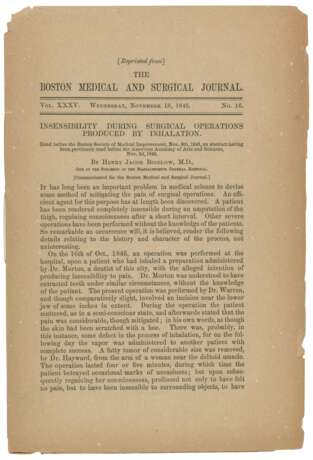ID 519331
Lot 41 | Henry Jacob Bigelow (1818-90).
Estimate value
£ 1 500 – 2 500
‘Insensibility During Surgical Operations Produced by Inhalation’. Reprinted from The Boston Medical and Surgical Journal. Vol. XXXV. No. 16. Wednesday, November 18, 1846. [n.p., n.d.].
First separate printing of the announcement of the discovery of surgical anaesthesia, the most significant contribution to medicine made in the United Sates during the nineteenth century. ‘It has long been an important problem in medical science to devise some method of mitigating the pain of surgical operations […]’. On 16 October 1846, at the Massachusetts General Hospital, W. T. G. Morton demonstrated the use of ether as an anaesthetic in an operation which was witnessed by, among others, Henry Jacob Bigelow. Morton had intended to keep his discovery secret in order to patent it, but after Bigelow communicated the results to the Academy of Arts and Sciences, Morton authorized him to publish a detailed account. This was first read before the Boston Society of Medical Improvements on the 9th of November and appeared shortly after in the Boston Medical and Surgical Journal. The present pamphlet is a resetting of the original article, but omits the last seven paragraphs which referred to Charles Jackson's (a Boston doctor) and Morton's proposed patent. Morton and Jackson were later involved in lawsuits to establish priority of discovery. Fulton and Stanton Anesthesia, IV.3; Cushing B-380; Norman One Hundred Books Famous in Medicine, 64a; Norman 233; cf. Welcome II p.166 (Journal); cf. Garrison & Morton 5651 (Journal).
Octavo (229 x 155mm). 4 leaves (lightly toned, some small chips to blank extremities). Stitched as issued; housed in custom modern cloth chemise and morocco-backed slipcase.
| Address of auction |
CHRISTIE'S 8 King Street, St. James's SW1Y 6QT London United Kingdom | |
|---|---|---|
| Preview |
| |
| Phone | +44 (0)20 7839 9060 | |
| Buyer Premium | see on Website | |
| Conditions of purchase | Conditions of purchase |



